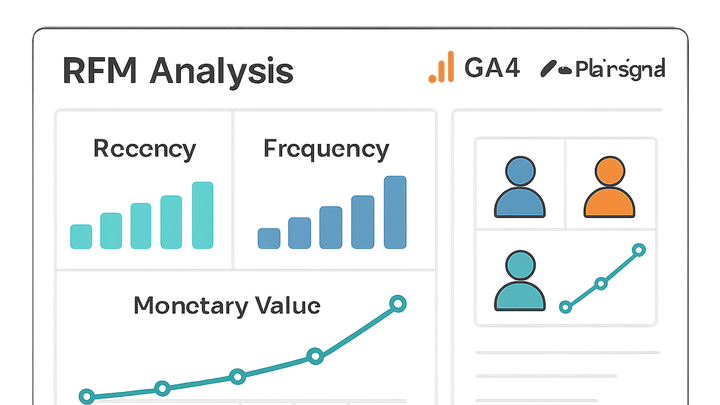Published on 2025-06-28T04:56:14Z
What is RFM Analysis? Examples for Customer Segmentation
RFM Analysis (Recency, Frequency, Monetary) is a proven data-driven technique used in analytics to evaluate and segment customers based on their purchasing behavior. Recency measures how recently a customer made a purchase, Frequency tracks how often they buy, and Monetary value sums the total revenue generated by each customer. This method helps marketers and analysts identify valuable customer groups, tailor campaigns, predict churn, and optimize retention strategies. RFM Analysis is simple yet powerful, and can be implemented using tools like Google Analytics 4 (GA4) for event tracking and custom definitions, or using cookie-free analytics platforms such as PlainSignal to maintain user privacy while gathering essential purchase data. By scoring customers across these three dimensions, organizations can prioritize high-value segments, personalize outreach, and ultimately increase lifetime value.
Rfm analysis
Customer segmentation method using Recency, Frequency, and Monetary metrics to optimize marketing and retention.
Core Components of RFM Analysis
RFM Analysis breaks down into three key metrics that capture customer behavior patterns. Each metric provides unique insights and, when combined, form a powerful segmentation tool.
-
Recency
Measures the time elapsed since a customer’s last purchase. Customers with more recent transactions often have higher engagement and are more likely to respond to marketing.
-
Frequency
Counts the number of purchases a customer has made in a defined period. Frequent buyers are generally more loyal and have predictable buying habits.
-
Monetary value
Calculates the total revenue contributed by a customer. High-spending customers represent greater value and often warrant special attention.
Why RFM Analysis Matters in Analytics
RFM Analysis is widely adopted due to its simplicity and effectiveness in identifying high-value customer segments. It underpins targeted marketing initiatives, improves resource allocation, and enhances retention strategies.
-
Identify high-value segments
Pinpoint customers who are both recently active and high spenders to focus promotional efforts where they yield the highest ROI.
-
Personalize marketing campaigns
Tailor messages based on customer scores. For instance, offer reactivation campaigns to customers with low recency but high monetary value.
-
Predict churn risk
Detect customers at risk of churn by analyzing declining recency and frequency scores, enabling proactive retention measures.
Implementation with GA4 and PlainSignal
Leverage GA4’s event tracking and PlainSignal’s cookie-free analytics to collect purchase events, then compute RFM scores for comprehensive customer insights.
-
Setting up PlainSignal tracking code
Embed PlainSignal’s script to capture user interactions and purchase events without cookies.
-
Example code
<link rel="preconnect" href="//eu.plainsignal.com/" crossorigin /><script defer data-do="yourwebsitedomain.com" data-id="0GQV1xmtzQQ" data-api="//eu.plainsignal.com" src="//cdn.plainsignal.com/plainsignal-min.js"></script>
-
-
Configuring GA4 events
Define custom purchase events and user properties in GA4. Send event parameters for transaction value and timestamps to compute RFM dimensions.
-
Calculating rfm scores
Extract purchase data from both platforms, rank customers on each metric into quintiles or custom bins, then aggregate scores to segment users.
Best Practices and Considerations
While RFM Analysis offers clear segmentation benefits, maintain data integrity, be aware of its limitations, and consider advanced enhancements for deeper insights.
-
Ensure data quality
Validate purchase event accuracy across GA4 and PlainSignal. Consistent data capture is essential for reliable scoring.
-
Understand limitations
RFM does not account for customer sentiment, product preferences, or external factors. Use it alongside other analytics methods.
-
Combine with predictive models
Integrate RFM segments with machine learning models for churn prediction or customer lifetime value forecasting to enhance decision-making.
